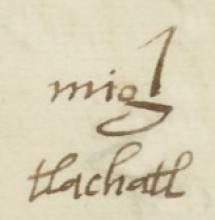Tlachatl (MH501v)
This black-line drawing of the compound glyph for the personal name Tlachatl (“Ball Court Water,” attested here as a man’s name) shows what appears to be a ball court (but also has the look of the sign for movement, olin). Its sides curve out, and the rings for the balls' goals are on the outside of the courts' sides. The sides have a thin stripe near the inner edges. Coming down and out of the court are two streams of water, with a droplet at the end of each stream, and a line of current in the middle of each one. The ink of the water is blacker than the ink of the ball court.
Stephanie Wood
Please see the examples of olin that somewhat echo the shape of this sign. It is significant that the ball court, where a rubber ball (olli) would be at play recalls the olin sign. Olli and olin are near homophones. Also, the movement of the bouncing rubber ball can have an association with the larger philosophical sense of movement that permeates the culture, as has been discussed at length by James Maffie in Aztec Philosophy (2014).
Stephanie Wood
migl
tlachatl
Miguel Tlachatl
Stephanie Wood
1560
Jeff Haskett-Wood
water, agua, cancha, court, balls, pelotas, movement, movimiento, nombres de hombres

tlach(tli), ball court, https://nahuatl.wired-humanities.org/content/tlachtli
a(tl), water, https://nahuatl.wired-humanities.org/content/atl
Matrícula de Huexotzinco, folio 501v, World Digital Library, https://www.loc.gov/resource/gdcwdl.wdl_15282/?sp=82&st=image
This manuscript is hosted by the Library of Congress and the World Digital Library; used here with the Creative Commons, “Attribution-NonCommercial-ShareAlike 3.0 License” (CC-BY-NC-SAq 3.0).





